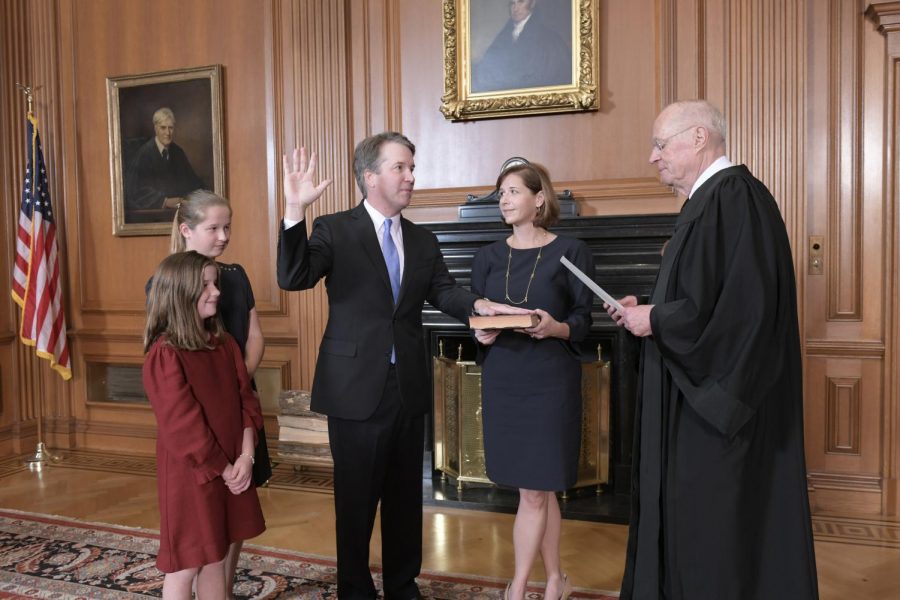New Supreme Court justice cements conservative lead
Tempered by misconduct allegations, Kavanaugh confirmation proceeds
October 17, 2018
Fred Schilling, Collection of the Supreme Court of the United States (supremecourt.gov)
The newly confirmed 114th Supreme Court Justice Brett Kavanaugh takes the Constitutional Oath, administered by Chief Justice John Roberts, accompanied by Kavanaugh’s wife, Ashley Estes Kavanaugh, and his two daughters, Liza and Margaret. The Senate confirmed Kavanaugh’s nomination in a 50-48 today.
One of the main reasons that Republicans want to secure their majority in the Senate is to support judicial decisions resulting from the nomination of Judge Brett Kavanaugh to the Supreme Court. Kavanaugh, a staunch conservative, had a far more likely chance of winning the Senate’s vote if the majority was Republican. Kavanaugh was confirmed with a vote of 50 to 48 on Oct. 6.
However, Kavanaugh’s nomination has also brought several accusations of sexual misconduct against him and a divided legislative body. On Sept. 16, Dr. Christine Blasey Ford, a psychology professor at Palo Alto University and a research psychologist at the Stanford University School of Medicine, publicly alleged that Kavanaugh had sexually assaulted her at a gathering in 1982 while they were both in high school.
In early July 2018, Dr. Ford contacted her Representative Anna Eshoo about her accusations after Kavanaugh was reported to be on Trump’s shortlist for Supreme Court nominees. Eshoo then met with California Senator Dianne Feinstein, who promised Dr. Ford that she would keep the information confidential.
After media outlets tracked down Dr. Ford’s identity, she recounted her experience to a reporter at The Washington Post, which then published an article with the accusations. Shortly after Ford came out, two other accusers, Deborah Ramirez and Julia Swetnick, also accused Kavanaugh of alleged incidents of sexual misconduct.
On Sept. 27, the Senate Judiciary Committee held a public hearing where both Dr. Ford and Kavanaugh testified. Ford alleged that Kavanaugh had “groped [her] and tried to take off [her] clothes” and she had “believed he was going to rape [her].” Later that afternoon, he testified that all sexual assault allegations were “totally false and outrageous.”
Dr. Ford’s testimony at the hearing resembled that of Anita Hill in 1991 when she accused then-Supreme Court nominee Clarence Thomas of sexual harassment. Hill experienced badgering and mistreatment from the Senate Judiciary Committee, which consisted of only white men at the time. The 11 Republicans on the current committee of 21 are all white men. Sex crimes prosecutor Rachel Mitchell asked both Dr. Ford and Kavanaugh questions on behalf of the Republicans.
In regards to Mitchell’s hiring, Judiciary Committee chairman Senator Chuck Grassley said he wished to provide “a forum to both Dr. Ford and Judge Kavanaugh on Thursday that is safe, comfortable and dignified.”
Kavanaugh’s and Dr. Ford’s testimony has created a divide in terms of voters and constituents. On Sept. 28, the Senate Judiciary Committee once again met to decide to either allow or stop Kavanaugh’s vote from reaching the Senate.
Senator Flake, the only Republican swing vote on the committee, voted in support of Kavanaugh but only after requesting that the Senate hearing be postponed by one week to give time for the FBI to conduct a background investigation on the sexual assault allegations.
On Oct. 6, the U.S. Senate confirmed Judge Brett Kavanaugh to the Supreme Court with a slim margin of 50-48. He was sworn in by Chief Justice John G. Roberts Jr. and retired Justice Anthony M. Kennedy shortly after the vote.
This piece was originally published in the pages of The Winged Post on October 17, 2018.
